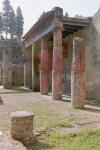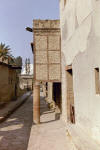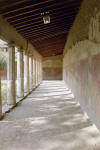|
The upmarket Roman seaside resort of
Herculaneum, near present day Naples, was buried by a flow of gas
and mud during the eruption of Mt Vesuvius on 24 August 79 CE (Common
Era - often called AD). This was the same
eruption that, famously, buried Pompeii. A section of the town has since been
excavated. (Photos by Mike Freedman) |
 |
 |
 |
 |
 |
|
These columns show a common method used
by the Romans. A brick pillar is rendered and the rendering partly
shaped to look like a fluted marble column. Notice how the columns
have been painted. |
This metal bath tub shows how little the
design of bathtubs has changed in over 2000 years. It's the best
shape so why change it? |
This picture shows the Roman equivalent
of a fast food restaurant. The counter has several earthenware pots
fixed into it which would have contained hot food. Being
earthenware, the pots would have helped conserve the heat. The front
step of the shop has a groove in which slid the concertina shutters
that were shut when the shop closed. |
Painted on a wall is this price list (or
perhaps it's a poster advertising the range of wines for sale). |
Many of the buildings in Herculaneum
have beautifully frescoes and mosaics. This mosaic has survived. The
decorations on the walls around it have not fared so well. |
|
202Kb |
167Kb |
221Kb |
153Kb |
219Kb |
|
Top |
 |
 |
 |
 |
 |
|
This overhanging building looks very "tudor"
in style. It may originally have been rendered to hide the wood
work. |
The strange object in the bottom of this
pool in the men's baths is an early immersion heater. The circular
piece in the centre was heated from below. |
Looking down from the current land
surface onto what was the docks. The wooden platform running across
the front of the arches was just above sea level. The building to
the right of the courtyard was the men's baths. At the time this
photograph was taken the arch to the left of the (modern) stairway
contained several human bones, including at least one skull! |
Another view of Herculaneum from the
current land surface. The photo gives an idea of the extent of the
excavations, which cover only about 1/4 of the original town. In the
distance can be seen the present-day town of Ercolano which has been
built on the volcanic material which covered the Roman town. |
This colonnaded walkway is at the Villa
Oplontis, not far from Mt Vesuvius. Like Herculaneum and Pompeii
this large suburban villa was engulfed by the eruption of Vesuvius
in 79 CE. Some restoration work has been done, particularly on the
roof, but the villa gives a fascinating insight into the life of a
rich family in Roman times. (It is reputed to have belonged to
Poppeia, the ill-fated wife of the Emperor Nero). |
|
173Kb |
145Kb |
168Kb |
193Kb |
|
|
Top |
 |
 |
 |
 |
 |
|
Books and websites about art history
often tell us that the artists of the Renaissance were the first to
discover how to show distance in paintings. This fresco in the Villa Oplontis
clearly shows that the Romans knew all about painting perspectives. |
Looking out of the window into a tiny
open courtyard, whose main function was probably to collect
rainwater, The walls of the courtyard are beautifully painted to
represent a garden. |
This exquisite little bird, pecking at a
fallen fig is around 2000 years old! |
Being close to the volcano, the villa
was overwhelmed by the pyroclastic flow of a fluidised mix of ash,
hot gas and water. In this room
the volcanic material had hardened around the timber window
shutters. Over time the shutters had rotted away leaving
shutter-shaped holes; early excavators then filled the holes with
plaster before digging away the volcanic material, leaving a plaster
cast of the shutters. |
The grey right hand wall of the
excavation in this view of part of the back of the villa clearly
shows the depth to which it was buried. |
|
168Kb |
167Kb |
44Kb |
161Kb |
191Kb |
|
Top |